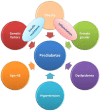Phenotyping the Prediabetic Population-A Closer Look at Intermediate Glucose Status and Cardiovascular Disease
- PMID: 34202289
- PMCID: PMC8268766
- DOI: 10.3390/ijms22136864
Phenotyping the Prediabetic Population-A Closer Look at Intermediate Glucose Status and Cardiovascular Disease
Abstract
Even though the new thresholds for defining prediabetes have been around for more than ten years, there is still controversy surrounding the precise characterization of this intermediate glucose metabolism status. The risk of developing diabetes and macro and microvascular disease linked to prediabetes is well known. Still, the prediabetic population is far from being homogenous, and phenotyping it into less heterogeneous groups might prove useful for long-term risk assessment, follow-up, and primary prevention. Unfortunately, the current definition of prediabetes is quite rigid and disregards the underlying pathophysiologic mechanisms and their potential metabolic progression towards overt disease. In addition, prediabetes is commonly associated with a cluster of risk factors that worsen the prognosis. These risk factors all revolve around a common denominator: inflammation. This review focuses on identifying the population that needs to be screened for prediabetes and the already declared prediabetic patients who are at a higher risk of cardiovascular disease and require closer monitoring.
Keywords: ASCVD; atherosclerosis; insulin resistance; macrovascular disease; prediabetes cluster; prognosis.
Conflict of interest statement
The authors declare no conflict of interest.
Figures



Similar articles
-
Editorial: Prediabetes: new insights on the diagnosis, risk stratification, comorbidites, cardiovascular disease, microvascular complications, and treatment.Front Endocrinol (Lausanne). 2023 May 11;14:1214479. doi: 10.3389/fendo.2023.1214479. eCollection 2023. Front Endocrinol (Lausanne). 2023. PMID: 37251678 Free PMC article. No abstract available.
-
The Importance of Prediabetes Screening in the Prevention of Cardiovascular Disease.Med Arch. 2023 Apr;77(2):97-104. doi: 10.5455/medarh.2023.77.97-104. Med Arch. 2023. PMID: 37260805 Free PMC article.
-
Diabetes, prediabetes and cardiovascular risk.Eur J Cardiovasc Prev Rehabil. 2010 May;17 Suppl 1:S9-14. doi: 10.1097/01.hjr.0000368192.24732.2f. Eur J Cardiovasc Prev Rehabil. 2010. PMID: 20489420 Review.
-
Dysglycemia/prediabetes and cardiovascular risk factors.Rev Cardiovasc Med. 2009 Fall;10(4):202-8. doi: 10.3909/ricm0474. Rev Cardiovasc Med. 2009. PMID: 20065930 Review.
-
The association between fasting plasma glucose and glycated hemoglobin in the prediabetes range and future development of hypertension.Cardiovasc Diabetol. 2019 Apr 27;18(1):53. doi: 10.1186/s12933-019-0859-4. Cardiovasc Diabetol. 2019. PMID: 31029146 Free PMC article.
Cited by
-
The Association Between Subclinical Atherosclerosis Serum Markers and Oxidative DNA Damage in Normoglycemic Normotolerant Offspring of Diabetic Parents.J Diabetes. 2025 Aug;17(8):e70133. doi: 10.1111/1753-0407.70133. J Diabetes. 2025. PMID: 40739796 Free PMC article.
-
Worldwide trends in prediabetes from 1985 to 2022: A bibliometric analysis using bibliometrix R-tool.Front Public Health. 2023 Feb 13;11:1072521. doi: 10.3389/fpubh.2023.1072521. eCollection 2023. Front Public Health. 2023. PMID: 36908460 Free PMC article.
-
The interaction of vitamin D supplementation with Omentin-1 gene polymorphism on metabolic factors and anthropometric indices in women with prediabetes: a study protocol for a double-blind randomized controlled trial.BMC Complement Med Ther. 2025 Aug 6;25(1):299. doi: 10.1186/s12906-025-05034-2. BMC Complement Med Ther. 2025. PMID: 40770752 Free PMC article.
-
Calanus Oil and Lifestyle Interventions Improve Glucose Homeostasis in Obese Subjects with Insulin Resistance.Mar Drugs. 2025 Mar 23;23(4):139. doi: 10.3390/md23040139. Mar Drugs. 2025. PMID: 40278260 Free PMC article. Clinical Trial.
-
Clustering-based risk stratification of prediabetes populations: Insights from the Taiwan and UK Biobanks.J Diabetes Investig. 2025 Jan;16(1):25-35. doi: 10.1111/jdi.14328. Epub 2024 Oct 10. J Diabetes Investig. 2025. PMID: 39387466 Free PMC article.
References
-
- Piller C. The war on ‘prediabetes’ could be a boon for pharma—But is it good medicine? Science. 2019 doi: 10.1126/science.aax2208. - DOI
Publication types
MeSH terms
Substances
LinkOut - more resources
Full Text Sources
Medical

